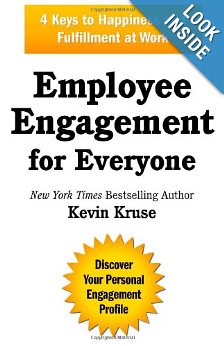This is a multi-part series on employee engagement based on my interview with New York Times best-selling author Kevin Kruse. As a former business owner and winner of a “Best Place to Work” award, Kevin has a wealth of real-life experience. I’m very grateful for the wisdom he is sharing with The People Equation readers.
 Today’s post addresses the issue of who is responsible for building employee engagement – and you might be surprised by Kevin’s answer.
Today’s post addresses the issue of who is responsible for building employee engagement – and you might be surprised by Kevin’s answer.
JVM: You’ve already written two books on employee engagement (We – How to Increase Performance and Profits through Full Engagement and Engagement 2.0). You’ve recently released a third – Employee Engagement is for Everyone. Why another book on employee engagement?
KK: In We, my co-author Rudy Karsan and I used a vast pool of engagement research. It was a far reaching book that tackled the notion of the changing workplace and the secrets to employee engagement. And as I started to do talks about the book a common theme emerged: This is great stuff, but what are our managers supposed to do on Monday [after they read the book and walk into their office, ready to apply these concepts]?
That is why I wrote Employee Engagement 2.0. It was a guide for managers on how to foster growth, recognition and trust in the work place. And then as I was doing talks for that book, I started getting a new question over and over which was “Why is engagement always a manager’s job or a company’s job? Why is it only about us?”
So, in a way, it was everyone trying to point the finger slightly at someone else is how [this book] came about. (Laughter)
JVM: The book Employee Engagement is for Everyone explores the question of “Who owns employee engagement?” Correct?
KK: It really brought up this idea which is: doesn’t the individual employee have a role to play? And what do managers do about those Debbie Downers or David Downers who are bringing a poor attitude to work? Is it really [a manager’s] job to turn them into engaged, people with a positive attitude?
And so that planted the seed. I researched positive psychology and started looking at what other people were doing in the area of self-motivation and workplace motivation. I stumbled upon a study from IDG Research that found that motivation can be attributed to intrinsic factors about 43% of the time, with the remaining 57% coming from extrinsic factors.
That is when I finally said, alright now I want to do a book [for employees] on engagement. I did the one big sprawling book, then I did one just for managers, now let me do a book for the individual employee.
JVM: So, employee engagement – are you saying the ownership is a roughly 50/50 proposition? It’s not just the company’s job, it is not just the manager’s job. In essence, it’s all of our jobs?
KK: Yeah and I think just to build on that further. One of the possible dangers of this book is that people might say that my message is, “Hey, companies don’t have to spend money on [building employee engagement] or “It’s not the manager’s job. It’s up to the individual to fix engagement problems themselves.” And that is not the message. Employee engagement is really about partnering. [My message is] “Let’s all have a partnership mindset.”
JVM: And the message that the management team should be communicating about employee engagement?
So the message that managers should be sending is: we’ll provide some training and tools to individuals that says, “listen if you are not comfortable doing this, this is how you can be proactive on engagement. Here’s how you can reach out to your supervisor to be a partner in this.”
JVM: Thanks, Kevin, for a great introduction to the premise for your book.
To see all of the posts in the Kevin Kruse Employee Engagement Series, click here.
Disclosure: some of the links in this post are affiliate links, meaning if you click the link and make a purchase (just viewing the link is free) then I may receive a commission.
Leave a Reply